Welcome to Demystifying Artificial Intelligence, a Movius blog post series where we will look at Artificial Intelligence through the lens of practical business applications. In the previous post, we discussed Data Science. Today, we will discuss Natural Language Processing and the role it plays in the very popular Conversational AI technology.
What is Natural Language Processing?
Natural Language Processing (NLP) are methods that provide machines with the ability to read and interpret human language. Its goal is to build systems that can make sense of text.
Example 1: Sentiment Analysis
One example of NLP is Sentiment Analysis. Sentiment Analysis allows machines to interpret whether a given phrase expresses positive, neutral, or negative opinion. This analysis involves detecting emotionally charged words and other clues. For example, phrases containing the words “happy”, “exciting”, or “cool” are likely expressing a positive opinion.
Example 2: Spam Detection
Another popular example is Spam Detection. Using NLP, email services can identify phrases that indicate a message is likely spam. This NLP analysis is used with other data about the email sender’s behavior (high send rate, identical messages), and the recipients’ behavior (low open rate, reports as spam) to make fairly good predictions on whether messages are spam.
What is Conversational AI?
NLP is an important component of Conversational AI. Conversational AI is the ability of a machine to interpret, understand, and respond logically to any human language. This allows us a more natural way to communicate to machines, rather than using “code” or a set of predetermined commands. This ability to talk to a machine as we talk to any other human holding a conversation is the essence of this technology. NLP guides the processing of the text while Conversational AI provides for the wider experience of dialogue, such as being able to respond to previous parts of the conversation or switching topics.
Conversational AI is popular
Yahoo Finance reports that “Global conversational artificial intelligence (AI) market was valued at USD 6.77 billion in 2021 and is expected to reach USD 37.94 billion by 2029.” The market is huge and so is the public interest.
Example: Chat GPT3
When OpenAI announced its release of Chat GPT3, social media was ablaze with people and brands sharing text they generated using the program. The quality of the responses from this technology enthralled the public and exposed a wider audience than ever to the capabilities of Conversational AI today.



The Movius Chat Bot powered by Curie
In the past few months, the AI team at Movius has produced a chat bot that you can talk to on the Movius Site. This bot was trained on manual examples and our existing chat data to respond to simple questions about Movius products. The bot can help visitors to the site schedule an introductory call with our Sales Team or find other areas of the site. As it receives more data from people who chat with it, it will continuously improve the quality of its responses.

Tip: Try asking the bot about the weather!
We hope this helped you understand the role Natural Language Processing plays in Artificial Intelligence. Come back next Thursday for the final post in the series, Demystifying AI: AI Analytics. If you want to be notified, please subscribe for updates! Learn more about our products at https://www.movius.ai/.
Authors:
Satish Medapati – Head of AI and Data Solutions
Melanie Allen – Product Marketing Content Writer




